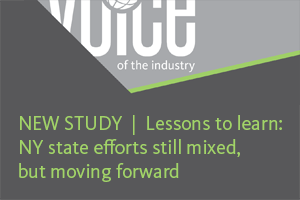
Fixing broken workers' compensation systems is far from easy. There are multiple agendas, complex legislation and competing needs – and often conflicting demands lead to "solutions" that seem to worsen the problem.
But still we try; and we should and must continue our efforts. Employees deserve the best possible care when injured. Employers deserve fair and predictable costs and a system that is streamlined, not burdened by inefficiency and out-of-control costs.
One state that is working to change its workers' compensation program is New York. Back in 2007, the state instituted sweeping reforms. Benefits have come from the reforms and subsequent efforts. For example, the state recently passed the Internet System for Tracking Over-Prescribing (ISTOP). It also engaged in a comprehensive "business process re-engineering" initiative to evaluate and "re-imagine" the state's workers' compensation system.
But there is a lot more to do. Costs remain high and some of the "fixes" aren't working as planned. After years of effort, many might be tempted to quit and not fight the system. Let's not do that. Now is the time to remember that often quoted saying, "if at first you don't succeed…" (we all know the rest).
The importance of trying and the benefits it can produce can be seen in the results of several states' workers' compensation reform efforts. For example, after reform efforts were instituted in California in 2004 it was discovered that, as written, the state's workers' compensation legislation was not always realizing the intended results. Injured workers had the ability to contest the denial of medical treatment requests via the utilization review process by having the matter evaluated by an administrative law judge. In 2012, a new law was passed instituting an independent medical review (IMR) panel. With trained independent physicians – rather than judges – making medical decisions, virtually overnight the majority of utilization review decisions were upheld via the IMR process.
Oklahoma had the sixth highest insurance premium rates according to a 2012 study.[1] Employers lamented that high workers' compensation costs were one of the primary reasons they were unable to hire and grow their businesses. To address the problem, several advocacy groups, including the Oklahoma Injury Benefits Coalition, began work on reform efforts. Despite setbacks, the Coalition never gave up and, on the third attempt, substantive reforms were passed in 2013. While clearly a variety of factors contributed, Oklahoma today has one of the most dynamic economies in the nation.
As a company doing business in New York and with multiple clients in the state, we want reform efforts to work. We've also seen the factors that have led to success in other states. For example, New York's ISTOP is a terrific program, but efforts also must be made to better control drug use through ODG-based formularies. Encouraging consensus when it comes to utilization review is a good concept. However, New York should consider whether it should be physicians or judges that make the final decision about what is clinically best for injured workers. Other states have moved to this approach.
One critical factor for success in many state efforts is the forming of broad-based coalitions committed to doing what is right. We are a part of those successful coalitions and want to work with employers, legislators and others in our industry to build a similar organization for New York. It will not be easy, but now is definitely the time to try, try again. To learn more about New York's and other states' efforts to improve, read our latest study.
What are your thoughts and experiences surrounding reform efforts in New York and other states? What do you think needs to be done?
Eddy Canavan, VP, Workers' Compensation Practice & Compliance
[1] 2012 Oregon Workers' Compensation Premium Rate Ranking Summary. October 2012